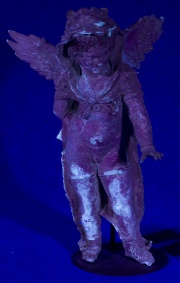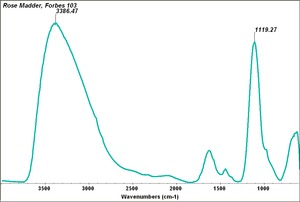Difference between revisions of "Rose madder"
Jump to navigation
Jump to search
| Line 17: | Line 17: | ||
<gallery> | <gallery> | ||
| − | File:01.7723 BT front.jpg|Statue under normal lighting conditions | + | File:01.7723 BT front.jpg|Statue under normal lighting conditions; MFA# 01.7723 |
| − | File:01.7723 BT front uv.jpg|Statue under ultraviolet light | + | File:01.7723 BT front uv.jpg|Statue under ultraviolet light; MFA# 01.7723 |
File:30_Rose_madder_200X.jpg|Rose madder | File:30_Rose_madder_200X.jpg|Rose madder | ||
</gallery> | </gallery> | ||
Latest revision as of 15:34, 27 June 2022
Description
A natural dark pink Madder colorant. Rose madder became popular as an artist pigment after the madder plant was imported to Holland in the 16th century. The colorant was extracted from madder roots with an acid, then the precipitate, primarily Pseudopurpurin, was redissolved in alum then reprecipitated with Calcium carbonate (chalk) to produce a pink lake (Schweppe and Winter 1997).
Synonyms and Related Terms
Natural red 9; rosa de garança (Port.); rose de garance (Fr.);
Physical and Chemical Properties
ASTM (1999) lightfastness = IV (poor)
Additional Images
Resources and Citations
- H.Schweppe, J.Winter, "Madder and Alizarin", Artists Pigments, Volume 3, E. West FitzHugh (ed.), Oxford University Press: Oxford, 1997.
- Ralph Mayer, A Dictionary of Art Terms and Techniques, Harper and Row Publishers, New York, 1969 (also 1945 printing)
- Comment: www.handprint.com - ASTM lightfastness = IV





